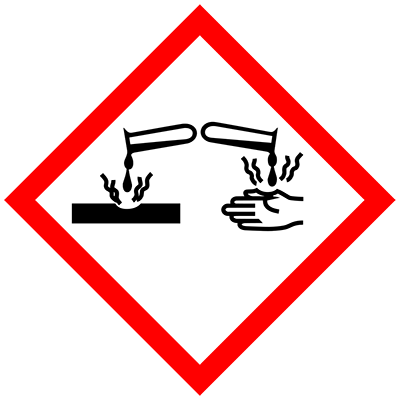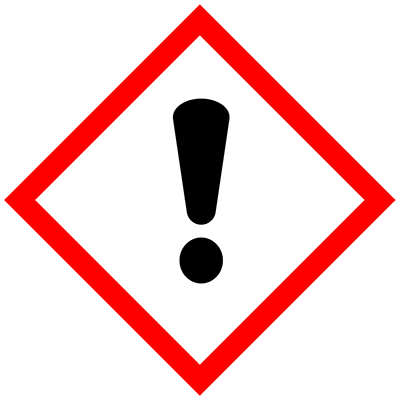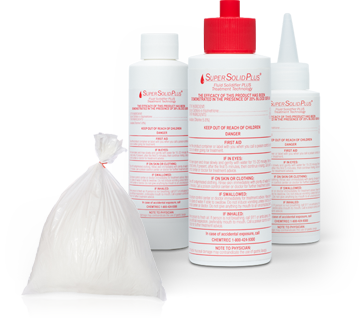SuperSolid Plus - SDS
Safety Data Sheet (SDS)
Date Prepared: March 16, 2015
View Print Friendly PDF
(requires Adobe Acrobat Reader)
1. PRODUCT AND COMPANY IDENTIFICATION
| Product name: | SuperSolid Plus® |
| Other means of identification: | Not applicable |
| Recommended use: | Liquid Medical Waste Treatment Technology |
| Restrictions on use: | Reserved for industrial and professional use. |
| Product dilution information: | Product is sold ready to use. |
| Company: |
DiSorb Systems, Inc.
1800 W. Indiana Avenue, Philadelphia, PA. 19132 1-215-207-9010 |
| Emergency telephone: | Chemtrec 1-800-424-9300 or +1 703-527-3887 (collect calls accepted) — CCN725242 |
| Issuing date: | 03/16/2015 |
2. HAZARDS IDENTIFICATION
GHS Classification
| Acute toxicity (Oral): | Category 4 |
| Acute toxicity (Inhalation): | Category 4 |
| Acute toxicity (Dermal): | Category 4 |
| Skin irritation: | Category 2 |
| Serious eye damage: | Category 1 |
GHS Label Element
| Hazard Pictograms: |
|
| Signal Word: | Danger |
| Hazard Statements: |
Causes serious eye damage.
Causes skin irritation. Harmful if swallowed, in contact with skin or if inhaled. |
| Precautionary Statements: |
Prevention:
Do not get in eyes, on skin, or on clothing. Wear protective gloves/eye protection/ face protection. Wash skin thoroughly after handling. Do not eat, drink or smoke when using this product. Avoid breathing dust/ fume/gas/mist/ vapors/ spray. Use only outdoors or in a well-ventilated area. Mixing this product with acid or ammonia releases chlorine gas. |
| Response: | IF SWALLOWED: Call a POISON CENTER or doctor/ physician if you feel unwell. IF ON SKIN: Wash with plenty of soap and water. IF INHALED: Remove victim to fresh air and keep at rest in a position comfortable for breathing. IF IN EYES: Rinse cautiously with water for several minutes. Remove contact lenses, if present and easy to do. Continue rinsing. Immediately call a POISON CENTER or doctor/physician. Rinse mouth. If skin irritation occurs: Get medical advice/attention. Take off contaminated clothing and wash before reuse. |
| Disposal: | Dispose of contents/ container to an approved waste disposal plant. |
| Other hazards: | None known. |
3. COMPOSITION/INFORMATION ON INGREDIENTS
| Pure substance/mixture: | Mixture |
| Chemical Name: | Sodium Dichloro s Triazinetrione Dihydrate |
| CAS-No.: | 51580-86-0 |
| Concentration (%): | 10.2 |
4. FIRST AID MEASURES
| In case of eye contact: | Rinse immediately with plenty of water, also under the eyelids, for at least 15 minutes. Remove contact lenses, if present and easy to do. Continue rinsing. Get medical attention immediately. |
| In case of skin contact: | Wash off immediately with plenty of water for at least 15 minutes. Use a mild soap if available. Get medical attention if irritation develops and persists. |
| If swallowed: | Rinse mouth. Get medical attention if symptoms occur. |
| If inhaled: | Remove to fresh air.Treat symptomatically. Get medical attention if symptoms occur. |
| Protection of first-aiders: | If potential for exposure exists refer to Section 8 for specific personal protective equipment. |
| Notes to physician: | Treat symptomatically. |
| Most important symptoms and effects, both acute and delayed: | See Section 11 for more detailed information on health effects and symptoms. |
5. FIRE-FIGHTING MEASURES
| Suitable extinguishing media: | Use extinguishing measures that are appropriate to local circumstances and the surrounding environment. |
| Unsuitable extinguishing media: | None known. |
| Specific hazards during fire fighting: | Not flammable or combustible |
| Hazardous combustion products: |
Decomposition products may include the following materials:
- Carbon oxides - Nitrogen oxides (NOx) - Sulfur oxides - Oxides of phosphorus |
| Special protective equipment for fire-fighters: | Use personal protective equipment. |
| Specific extinguishing methods: | Fire residues and contaminated fire extinguishing water must be disposed of in accordance with local regulations. In the event of fire and/or explosion do not breathe fumes |
6. ACCIDENTAL RELEASE MEASURES
| Personal precautions, protective equipment and emergency procedures: | Ensure adequate ventilation. Keep people away from and upwind of spill/leak. Avoid inhalation, ingestion and contact with skin and eyes. When workers are facing concentrations above the exposure limit they must use appropriate certified respirators. Ensure clean-up is conducted by trained personnel only. Refer to protective measures listed in sections 7 and 8. |
| Environmental precautions: | Do not allow contact with soil, surface or ground water. |
|
Methods and materials for containment and cleaning up:
|
Stop leak if safe to do so. Contain spillage, and then collect with non-combustible absorbent material, (e.g. sand, earth, diatomaceous earth, vermiculite) and place in container for disposal according to local / national regulations (see section 13). Flush away traces with water. For large spills, dike spilled material or otherwise contain material to ensure runoff does not reach a waterway. Do not flush into surface water or sanitary sewer system. |
7. HANDLING AND STORAGE
| Advice on safe handling: | Do not get in eyes, on skin, or on clothing. Wash hands thoroughly after handling. Mixing this product with acid or ammonia releases chlorine gas. |
| Conditions for safe storage: | Keep out of reach of children. Store in suitable labeled containers. |
| Storage temperature: | 0 °C to 35 °C |
8. EXPOSURE CONTROLS/PERSONAL PROTECTION
Ingredients with workplace control parameters
Substances for which there are Community workplace exposure limits.
| Engineering measures: | Effective exhaust ventilation system. Maintain air concentrations below occupational exposure standards |
Personal protective equipment
| Eye protection: |
Safety goggles
Face-shield |
| Hand protection: |
Wear the following personal protective equipment:
Standard glove type. Gloves should be discarded and replaced if there is any indication of degradation or chemical breakthrough. |
| Skin protection: | No special protective equipment required. |
| Respiratory protection: | No personal respiratory protective equipment normally required. |
| Hygiene measures: | Handle in accordance with good industrial hygiene and safety practice. Wash face, hands and any exposed skin thoroughly after handling. Provide suitable facilities for quick drenching or flushing of the eyes and body in case of contact or splash hazard. |
9. PHYSICAL AND CHEMICAL PROPERTIES
| Appearance: | powder |
| Color: | off-white |
| Odor: | Chlorine |
| pH: | 6.0 - 7.0 |
| Flash point: | Not applicable |
| Odor Threshold: | No data available |
| Melting point/freezing point: | No data available |
| Initial boiling point and boiling range: | No data available |
| Evaporation rate: | No data available |
| Flammability (solid, gas): | No data available |
| Upper explosion limit: | No data available |
| Lower explosion limit: | No data available |
| Vapor pressure: | No data available |
| Relative vapor density: | No data available |
| Relative density: | No data available |
| Water solubility: | insoluble |
| Solubility in other solvents: | No data available |
| Partition coefficient: n-octanol/water: | No data available |
| Autoignition temperature: | No data available |
| Thermal decomposition: | No data available |
| Viscosity, kinematic: | No data available |
| Explosive properties: | No data available |
| Oxidizing properties: | No data available |
| Molecular weight: | No data available |
| VOC: | No data available |
10. STABILITY AND REACTIVITY
| Chemical stability: | Stable under normal conditions. |
| Possibility of hazardous reactions: | No dangerous reaction known under conditions of normal use |
| Conditions to avoid: | None known. |
| Incompatible materials: | Acids |
| Hazardous decomposition products: |
Decomposition products may include the following materials:
- Carbon oxides - Nitrogen oxides (NOx) - Sulfur oxides - Oxides of phosphorus |
11. TOXICOLOGICAL INFORMATION
| Information on likely routes of exposure: | Inhalation, Eye contact, Skin contact |
Potential Health Effects
| Eyes: | Causes serious eye damage. |
| Skin: | Causes skin irritation. Harmful in contact with skin. |
| Ingestion: | Harmful if swallowed. |
| Inhalation: | Harmful if inhaled. |
| Chronic Exposure: | Health injuries are not known or expected under normal use. |
Experience with human exposure
| Eye contact: | Redness, Pain, Corrosion |
| Skin contact: | Redness, Irritation |
| Ingestion: | No information available. |
| Inhalation: | No information available. |
Toxicity
| Acute oral toxicity: | Acute toxicity estimate : 500 mg/kg |
| Acute inhalation toxicity: | Acute toxicity estimate : 1.5 mg/l |
| Acute dermal toxicity: | Acute toxicity estimate : 1,100 mg/kg |
| Skin corrosion/irritation: | Skin irritation |
| Serious eye damage/eye irritation: | Irreversible effects on the eye |
| Respiratory or skin sensitization: | No data available |
| Carcinogenicity: | No data available |
| Reproductive effects: | No data available |
| Germ cell mutagenicity: | No data available |
| Teratogenicity: | No data available |
| STOT-single exposure: | No data available |
| STOT-repeated exposure: | No data available |
| Aspiration toxicity: | No data available |
12. ECOLOGICAL INFORMATION
Ecotoxicity
| Environmental effects: | This product has no known ecotoxicological effects. |
Product
| Toxicity to fish: | No data available |
| Toxicity to daphnia and other aquatic invertebrates: | No data available |
| Toxicity to algae: | No data available |
Ingredients
| Toxicity to daphnia and other aquatic invertebrates: | Sodium Dichloro s Triazinetrione Dihydrate 48 h EC50 Daphnia : 0.196 mg/l |
| Persistence and degradability: | No data available |
| Bioaccumulative potential: | No data available |
| Mobility in soil: | No data available |
| Other adverse effects: | No data available |
13. DISPOSAL CONSIDERATIONS
| Disposal methods: | The product should not be allowed to enter drains, water courses or the soil. Where possible recycling is preferred to disposal or incineration. If recycling is not practicable, dispose of in compliance with local regulations. Dispose of wastes in an approved waste disposal facility. |
| Disposal considerations: | Dispose of as unused product. Empty containers should be taken to an approved waste handling site for recycling or disposal. Do not re-use empty containers. |
14. TRANSPORT INFORMATION
The shipper/consignor/sender is responsible to ensure that the packaging, labeling, and markings are in compliance with the selected mode of transport.
| Land transport (DOT): | Not dangerous goods |
| Sea transport (IMDG/IMO): | Not dangerous goods |
15. REGULATORY INFORMATION
| EPA Registration number: | 86042-1 |
EPCRA - Emergency Planning and Community Right-to-Know
CERClA Reportable Quantity
This material does not contain any components with a CERCLA RQ.This material does not contain any components with a CERCLA RQ.
SARA 304 Extremely Hazardous Substances Reportable Quantity
This material does not contain any components with a section 304 EHS RQ.
| SARA 311/312 Hazards: | Acute Health Hazard |
| SARA 302: | No chemicals in this material are subject to the reporting requirements of SARA Title III, Section 302. |
| SARA 313: | This material does not contain any chemical components with known CAS numbers that exceed the threshold (De Minimis) reporting levels established by SARA Title III, Section 313. |
California Prop 65
This product does not contain any chemicals known to the State of California to cause cancer, birth, or any other reproductive defects.
The ingredients of this product are reported in the following inventories:
| United States TSCA Inventory: | On TSCA Inventory |
| Canadian Domestic Substances list (DSl): | All components of this product are on the Canadian DSL. |
| Australia Inventory of Chemical Substances (AICS): | not determined |
| New Zealand. Inventory of Chemical Substances: | On the inventory, or in compliance with the inventory |
| Japan. ENCS - Existing and New Chemical Substances Inventory: | not determined |
| Japan. ISHl - Inventory of Chemical Substances (METI): | not determined |
| Korea. Korean Existing Chemicals Inventory (KECI): | On the inventory, or in compliance with the inventory |
| Philippines Inventory of Chemicals and Chemical Substances (PICCS): | On the inventory, or in compliance with the inventory |
| China. Inventory of Existing Chemical Substances in China (IECSC): | On the inventory, or in compliance with the inventory |
16. OTHER INFORMATION
| NFPA |
[See PDF] |
| HMIS III |
[See PDF] |
| Issuing date: | 03/16/2015 |
| Version: | 1.0 |
| Prepared by: | Regulatory Affairs |
REVISED INFORMATION:
Significant changes to regulatory or health information for this revision is indicated by a bar in the left-hand margin of the SDS.
The information provided in this Material Safety Data Sheet is correct to the best of our knowledge, information and belief at the date of its publication.The information given is designed only as a guidance for safe handling, use, processing, storage, transportation, disposal and release and is not to be considered a warranty or quality specification.The information relates only to the specific material designated and may not be valid for such material used in combination with any other materials or in any process, unless specified in the text.
SuperSolid Plus
SuperSolid Plus is an EPA registered liquid medical waste treatment technology that combines all of the safety benefits of our original SafeSorb solidifier with a powerful Treatment Technology to further reduce the risk of exposure to dangerous bloodborne pathogens.
Learn More

